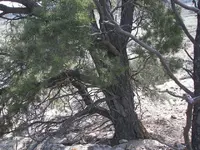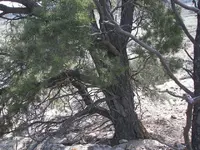JT
Full Member
- Joined
- Mar 14, 2005
- Messages
- 211
- Reaction score
- 67
- Golden Thread
- 0
- Location
- Johns Island, South Carolina
Like I said, I hope you are relying on false info, and are not trying to run an eventual scam on someone based on your "info" and "prowess" in finding something.
I've never seen someone defend to the death the hypothesis that they found a hole where treasure USED to be. I can see defending your hypothesis if you had actually found something...anything. Even a plaque from Schultz saying "I buried money here".
You don't have that. You don't have anything. The proof you offer up..... your own picture of the tree..... shoots down your theory. It doesn't prove that Schultz hid anything there, left a beer bottle there, or even peed in the bushes there.
What it does prove is that either you don't have the commonsense to realize that your "evidence" cannot be true, or it proves that you're lying, and you carved the date on the tree, because I've already established that the size of the tree coupled with tight bark and fresh wood under it means it cannot be 75 or 80 years old.
Everyone makes wrong conclusions, and that's ok. It's part of the hunt. If you want to stubbornly insist that you found the correct empty hole, and you want to be considered the "resident expert" on the Schultz cache, as you put it, then go right ahead. The majority of people that look at your "evidence" will realize that it doesn't pass the smell test.
If you are trying to work an angle to scam money from some unsuspecting sap, I hope he/she reads this, and walks away before it's too late. You may be perfectly honest, and you may truly believe that you are correct, but something about your posts gives me the opposite impression. I hope I'm wrong.
I've never seen someone defend to the death the hypothesis that they found a hole where treasure USED to be. I can see defending your hypothesis if you had actually found something...anything. Even a plaque from Schultz saying "I buried money here".
You don't have that. You don't have anything. The proof you offer up..... your own picture of the tree..... shoots down your theory. It doesn't prove that Schultz hid anything there, left a beer bottle there, or even peed in the bushes there.
What it does prove is that either you don't have the commonsense to realize that your "evidence" cannot be true, or it proves that you're lying, and you carved the date on the tree, because I've already established that the size of the tree coupled with tight bark and fresh wood under it means it cannot be 75 or 80 years old.
Everyone makes wrong conclusions, and that's ok. It's part of the hunt. If you want to stubbornly insist that you found the correct empty hole, and you want to be considered the "resident expert" on the Schultz cache, as you put it, then go right ahead. The majority of people that look at your "evidence" will realize that it doesn't pass the smell test.
If you are trying to work an angle to scam money from some unsuspecting sap, I hope he/she reads this, and walks away before it's too late. You may be perfectly honest, and you may truly believe that you are correct, but something about your posts gives me the opposite impression. I hope I'm wrong.







